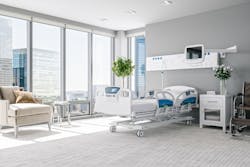Patients, Staff at the Center of Healthcare Design Trends in 2023
Nothing changes behavior and creates innovation more quickly than turmoil, and it seems clear that the past few years has seen quite a bit of both in the healthcare field. While we’d like to think that the pandemic is in the rearview mirror, new cases are still being reported ongoing which impacts the healthcare community and their respective spaces. Architects, designers and manufacturers have taken stock of these needs, and they are re-imagining safe, healthy and engaging new environments that deliver for patients, providers and workers. After all, spaces shape the experience of everyone who utilizes that space.
So, what are the trends for healthcare design as we move into the new year? We looked at three areas where design and innovation meet wellbeing. Research shows that medical employees are subjected to some of the worst health-performing criteria, from shift work to high stress, so supporting wellness helps engage and retain existing employees, mitigates risks to physical and mental health of everyone and provides an environment that sustains all who walk through its doors.
Daylighting
Maximizing visual comfort while reducing energy costs is the double benefit of daylighting and why so many architects have been designing facilities to leverage both. Daylighting is defined as the practice of placing windows, skylights, other openings and reflective surfaces so sunlight can provide effective internal lighting. Particular attention is given to daylighting while designing a building when the aim is to maximize visual comfort or to reduce energy use.
The advantages of incorporating daylighting into buildings goes beyond energy and thermal use, however. With the creative placement of windows and glass, smaller rooms can appear larger. There is also value to using artistic glass (on floors, walls and even elevators) to engage staff and patients. Unlike fabric or wallpaper, glass is easily maintained and easy to clean. A few of the many known benefits of daylighting include:
- Access to daylight and views to natural environments support health and well-being
- Natural light supports alertness, sleep quality and mood
- Prevention of Season Affective Disorder (SAD)
- Energy savings
The Environment: Mitigation of VOCs—Silent Toxins
- Central heating and cooling systems
- Cleaning products
- Deteriorated asbestos-containing insulation
- Radon pesticides and outdoor air pollution
- Stains, dyes, varnishes, paints, etc.
- Glues and adhesives
- Wood preservatives on cabinetry or furniture made from certain pressed wood that can release formaldehyde into the environment
- Newly installed flooring, upholstery or carpet
- Office equipment such as copiers and printers
- Graphics and craft materials including permanent markers and photographic solutions
The relationship between humans and the environment they inhabit is called Occupant Health, and there are very strong correlations between the two. Everything from air quality to mold and microbe mitigation and even the life cycle of products used in building are being addressed by manufacturers and the architects and designers tasked with creating safe and healthy spaces.
Inadequate ventilation can increase indoor pollutant levels which can have dire effects on patients. According to the EPA, “Other health effects may show up either years after exposure has occurred or only after long or repeated periods of exposure. These effects, which include some respiratory diseases, heart disease and cancer, can be severely debilitating or fatal. It is prudent to try to improve the indoor air quality in your home [and other buildings] even if symptoms are not noticeable.”
In addition to VOCs, there are a number of other design considerations architects and designers should keep in mind when planning healthcare environments that better support staff and patients. Here are a few:
- Spaces should be designed to encourage physical movement
- Ergonomic furniture improves productivity; studies show this one change can increase productivity up to 15% or more
- Noise control; provide a variety of open and enclosed spaces to decrease noise disruption. Design with absorptive materials
- Ensure access to daylight and adjustable indoor lighting
- Choose surfaces that enhance the natural light
- Include biophilic design practices
Barrier-Free Bathrooms
An important benefit of this type of set-up for the healthcare facility is the ease of maintenance since the entire shower can be hosed down. Aside from fixtures and furniture like shower benches and adjustable hand showers, one of the most important design considerations is construction of the room.
To achieve an ideal installation, floor heights should be equal between the shower area (wet area), outside the shower (dry area) and next room. Preferably, installation should include a linear drain, as the drain needs to span from wall-to-wall inside the shower enclosure a minimum of 60 inches. This keeps water from pooling under the shower seat and allows a consistent one-plane floor pitch.
For flooring, ceramic tiles are the perfect choice when it comes to all bathroom surfaces. Not only are they slip-resistant, but they are easy-to-maintain, highly durable, impervious to water, fire and scratches. They also establish a seamless transition between the wet and dry areas of the bathroom.
By considering these trends, architects and designers can help create inviting, healthy and functional healthcare spaces that benefit everyone.



